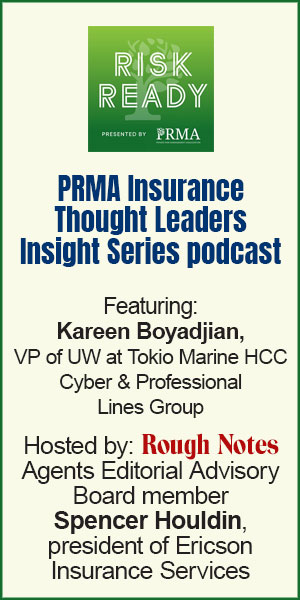Earthquake insurance is a hard sell for clients who haven’t witnessed an earthquake. Other factors combine to make it even harder. What should you know to help protect clients?
Earthquake Insurance
When the big one happens, who will they come for?
By Joseph S. Harrington, CPCU
Missouri has long been known for being in the center of America, in politics and sentiment as well as location. If, therefore, the Show Me state is an indicator of our national preparedness for disaster, things are not looking good.
In July 2021, the Missouri Department of Commerce and Insurance (DCI) issued a report with findings that were shocking yet not surprising, at least to risk professionals: In the first 20 years of this century, the number of residences insured for earthquake in the state fell by nearly half, from 43.6% to 25.7% overall, and from 60.2% to 12.7% in high-risk counties along the New Madrid fault line.[1]
(The New Madrid fault runs roughly along the Mississippi River from the southern tip of Illinois to a point south of the border of Tennessee and Mississippi. It presents a direct seismic threat to St. Louis, Memphis, and Evansville, Indiana; any shockwaves will be felt well beyond those cities.)
What, me worry?
Cost and complacency appear to be the principal reasons for the decline in residential earthquake coverage.
There hasn’t been a major earthquake along the New Madrid fault line since 1895, and a 1999 article in the journal Science suggested there may not be another for centuries to come, if ever. That view is contested, however.[2]
Officials throughout the region want their constituents to be prepared for anything remotely like the series of quakes that rocked the area over three months in 1811-1812. Shockwaves from those quakes were so strong they reportedly rang church bells in Boston. The Central U.S. Earthquake Consortium estimates that a repeat of that experience would result in more than $200 billion in damages today.[3]
If the danger of earthquake had diminished, you certainly wouldn’t tell by the cost of residential earthquake insurance, which has increased fourfold in Missouri since the year 2000, and by a staggering 760% over the same period in the New Madrid counties. Hence, it’s no surprise the state has seen a widespread decline in the take-up rate for earthquake coverage.[4]
At the same time, Missouri is one of several Midwestern states that saw its number of policies written under the National Flood Insurance Program (NFIP) fall precipitously over the past decade. Despite repeated flooding along the Missouri River, the number of NFIP policies in Missouri fell from nearly 28,000 in 2011 to fewer than 20,000 in 2019. (Some of the decline may be attributed to growth in private flood insurance.)[5]
In the crosshairs
The point here is not to pick on Missouri, but only to illustrate how trends in that state reflects a broader national retreat from preparation for the financial impact of mega-disasters.
Events of such magnitude would require massive public expenditures on an emergency basis for recovery. To the extent such funding is slow in coming or deemed insufficient, agents and brokers will find themselves in the crosshairs of plaintiffs seeking recovery through errors and omissions (E&O) claims against their insurance counselors.
[N]ot to pick on Missouri, but … trends in that state reflect a broader national retreat from preparation for the financial impact of mega-disasters.
We’re seeing something like that with E&O claims arising from the COVID-19 pandemic, as some insureds allege they were not adequately informed about the limitations of standard business interruption coverage or the existence of coverage (from a few carriers) for business interruption losses caused by a pandemic.
Producers are well-advised to make it loud and clear to their clients that most residential and commercial property policies do not cover structural damage due to earthquakes, and that, to get the coverage, an insured must typically purchase an earthquake coverage endorsement or a stand-alone earthquake policy.
Complications
That’s a hard enough sell for clients who haven’t witnessed an earthquake. Other factors combine to make it even harder.
First off, property insurers not required to make earthquake coverage available in all states. (California is a significant exception, where homeowners insurers are required to offer earthquake coverage.)
According to the Missouri DCI report, carriers accounting for roughly half the state’s homeowners market offer earthquake coverage for frame and masonry veneer structures. Less than a quarter of the market offers earthquake coverage for all types of structures, and more than a sixth—including nearly 20% in the New Madrid zone—don’t offer earthquake coverage at all.[6]
Thus, in contrast to flood insurance, where there is always one “go to” source of coverage (the NFIP), agents and brokers might be constrained from recommending an otherwise suitable property policy to a client if the carrier does not offer earthquake coverage.
Then, to a buyer, earthquake coverage will appear to have a narrow application, at least conceptually.
Earthquake insurance typically covers so-called “shake” damage, i.e., structural damage caused by earth movement, plus debris removal and resulting business interruption. There is typically no coverage under an earthquake endorsement or policy for losses due to landslides or mudslides. Also, damage from fire caused by an earthquake, referred to as “fire following earthquake,” is commonly covered under standard property policies.
Given these qualifications, one can understand why an insurance buyer would choose to forgo coverage for a peril that is out of sight and, perhaps, out of mind. They’ll remember, however, if the “big one” ever hits, and producers will want to be able to say “I told you so.”
[1] Missouri Department of Commerce and Insurance, Residential Earthquake Coverage in Missouri, July 2020, p. 3; accessed at https://insurance.mo.gov/earthquake/documents/OverviewofResidentialEarthquakeInsurance
in2020.pdf
[2] Stanford University, “New Madrid Earthquakes Still Threaten The Central United States, Scientists Conclude,” ScienceDaily, Sept. 29, 2000; accessed at www.sciencedaily.com/releases/2000/09/000929072432.htm
[3] Central US Earthquake Consortium, Central US Earthquake Guide, 2009, p. 7; accessed at https://www.in.gov/dhs/files/Central_US_Earthquake_Guide.pdf
[4] Missouri DCI, op. cit., p. 4
[5] Insurance Information Institute, National Flood Insurance Program Policies by State, archived tables; accessed at https://www.iii.org/table-archive/20880
[6] Missouri DCI, op. cit., p. 18
The author
Joseph S. Harrington, CPCU, is an independent business writer specializing in property and casualty insurance coverages and operations. For 21 years, Joe was the communications director for the American Association of Insurance Services (AAIS), a P-C advisory organization. Prior to that, Joe worked in journalism and as a reporter and editor in financial services.





